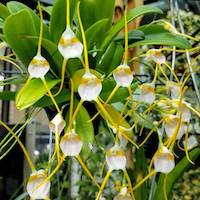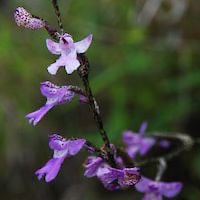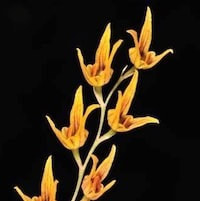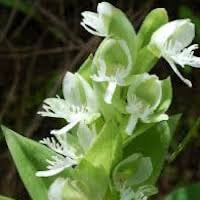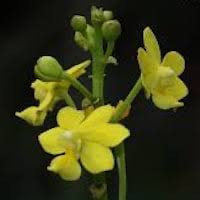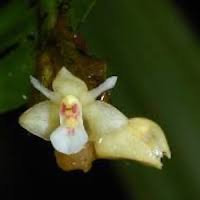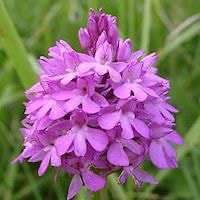Rediscover Serenity with Natural Woody Aromatherapy for Men
The fragrance crafted by Scentopia features captivating notes of Masdevallia Mejiana, a native Singaporean orchid species known for its mini-miniature size and tufted, epiphytic growth habit. With its erect leaves and numerous spikes of white bell-like flowers exuding a sweet scent reminiscent of lily-of-the-valley, Masdevallia Mejiana adds a delightful touch to the perfume. The fragrance is further enriched with a hint of spice, complementing the lily-of-the-valley aroma.
Complementing the Native Singaporean Orchid notes, the fragrance incorporates Therapeutic Orchid notes from several orchid species with unique properties:
To complete the fragrance, water notes, spices, amber, fresh woods, pepper, and mahogany are added, creating a unique and captivating olfactory experience. Scentopia's Woody 4 (Men) for Team building Perfume workshop fragrance offers an alluring blend of native orchids and therapeutic scents, making it an enticing choice for those seeking a distinctive and invigorating fragrance.
Complementing the Native Singaporean Orchid notes, the fragrance incorporates Therapeutic Orchid notes from several orchid species with unique properties:
- Hemipiliopsis purpureopunctata (K.Y. Lang) Y.B. Luo & S.C. Chen Syn. Habenaria purpureopunctata K.Y.: This orchid species is found in southeast Xizang and northeast India. In China, it is used to relax tense muscles, and the entire plant is utilized for its therapeutic properties.
- Bulbophyllum reptans: Known as Fushengshidou Lan, Baihuashidou Lan, or Shilianzi in Chinese, this orchid enriches yin and aids in clearing phlegm. It is known to contain several phenanthrenes with various medicinal properties, including improving appetite, digestion, and relieving dry throat.
- Habenaria pectinata D. Don: Also called Jianyeyufeng Hua, this terrestrial orchid species is found in temperate northeast India, Nepal, and Yunnan. Its leaves are crushed and used to treat snake bites in India, while the whole plant is employed in China to treat coughs, nephritis, and waist pain.
- Taprobanea spathulata (L.) Christenson. Syn. Vanda spathulata (L.) Spreng: Used to treat diseases involving nerves, rheumatism, and scorpion stings, this orchid is also known as Ponnamponmaraiva in the Malaya- lam dialect. It is considered one of the "Indigenous Drugs of India."
- Agrostophyllum stipulatum ssp. bicuspidatum: Known as Heye Lan in Chinese, this orchid is associated with mythical qualities among certain communities. It contains various medicinal chemicals, including stilbenoids, phenanthrenes, and alkaloids, known for their antimicrobial, antihelminthic, anti-inflammatory, and anticancer properties.
- Anacamptis pyramidalis: Used to make Salep in Turkey and Iran, this orchid has mucin content and phytoalexins (orchinol and p-hydroxybenzyl alcohol) beneficial for skin whitening and antioxidant properties.
To complete the fragrance, water notes, spices, amber, fresh woods, pepper, and mahogany are added, creating a unique and captivating olfactory experience. Scentopia's Woody 4 (Men) for Team building Perfume workshop fragrance offers an alluring blend of native orchids and therapeutic scents, making it an enticing choice for those seeking a distinctive and invigorating fragrance.
Download the guided mediation that works best with this Orchid fragrance oil
| men_woody_essential_oil_orchi_00004.mp3 | |
| File Size: | 190097 kb |
| File Type: | mp3 |
Embrace Masculine Tranquility with Woody Scented Elixir
Contains Scented Notes of following in various proportions:
Native Singaporean Orchid notes: Masdevallia Mejiana
|
Masdevallia Mejiana - Used in Woody 4 (Men) for Team building Perfume workshop
Masdevallia mejiana is a mini-miniature sized, warm-growing, tufted epiphytic orchid. It is known for its numerous spikes of white, bell-like flowers and a sweet scent that resembles the fragrance of lilies-of-the-valley with a hint of spice. The strong floral bouquet of this orchid is easily detectable when the plant is in full flower. In the context of a perfume workshop (Woody 4), Masdevallia mejiana can be used to add its unique lily-of-the-valley and spice scent to the perfume blends. The pleasant aroma of this orchid can contribute to the overall fragrance profile of the perfume and create a distinctive and appealing scent for the participants. |
Therapeutic Orchid notes:
|
Hemipiliopsis purpureopunctata (K.Y. Lang) Y.B. Luo & S.C. Chen Syn. Habenaria purpureopunctata K.Y.
Hemipiliopsis purpureopunctata (previously known as Habenaria purpureopunctata) is a plant that flowers from June to July. It is found in various habitats, including broad-leaved evergreen forests, alpine oak forests, grassy slopes, and sandy river banks in southeast Xizang (Tibet) and northeast India. In Chinese herbal medicine, the herb is used for its muscle-relaxing properties. The entire plant is utilized for its medicinal benefits. It is believed to have properties that help relax tense muscles and provide relief from muscle-related discomfort. For applications in Woody 5 (Men) for a Team building Perfume workshop, the fragrance of Hemipiliopsis purpureopunctata could potentially add an interesting herbal note with its muscle-relaxing associations. Perfumers could use it to create a unique and well-balanced perfume blend, adding complexity and depth to the overall fragrance. |
|
Bulbophyllum reptans
Chinese name: Fushengshidou Lan (conceal life stone bean orchid); Baihuashidou Lan; Shidou Lan Chinese medicinal name: Shilianzi Bulbophyllum reptans, also known as Fushengshidou Lan, Baihuashidou Lan, or Shidou Lan in Chinese, is a species of orchid with medicinal properties. In traditional Chinese medicine, it is referred to as Shilianzi. According to traditional beliefs, Bulbophyllum reptans is believed to enrich Yin, a concept in traditional Chinese medicine related to the nourishment and cooling of the body. It is also used for clearing phlegm, improving appetite, aiding digestion, and relieving dry throat. The plant contains several phenanthrenes, which are a class of compounds with potential medicinal properties. Some of the identified phenanthrenes in Bulbophyllum reptans include coelonin, flavanthrin, confusarin, gynopusinblestriarene A (flavanthrin), cirrhopetalanthrin, reptanthrin, and isoreptanthrin. In the context of the Woody 5 (Men) Team building Perfume workshop, perfumers could utilize the unique herbal scent of Bulbophyllum reptans to create a fragrance that has potential therapeutic associations. The presence of phenanthrenes in the plant may also contribute to the complexity and character of the perfume, providing interesting and distinct aromatic notes. |
|
Habenaria pectinata D. Don
Chinese name: Jianyeyufeng Hua Indian name: Safed musli Habenaria pectinata, also known as Jianyeyufeng Hua in Chinese and Safed musli in Indian name, is a terrestrial orchid species found in temperate regions of northeast India, Nepal, and Yunnan. It typically grows in shady areas on the edges of temperate forests at elevations of 1800 to 3000 meters in the Indian Himalayas. In traditional herbal usage, Habenaria pectinata has been employed for various medicinal purposes in India and China:
|
|
Taprobanea spathulata (L.) Christenson. Syn. Vanda spathulata (L.) Spreng
Indian name: Ponnamponmaraiva in the Malaya- lam dialect Taprobanea spathulata (synonym Vanda spathulata) is an orchid species known by various names, including Ponnamponmaraiva in the Malaya-lam dialect. This epiphytic orchid is found in India and other regions of Southeast Asia. In traditional herbal usage, Taprobanea spathulata has been utilized for treating various health conditions in India:
|
|
Agrostophyllum stipulatum ssp. bicuspidatum .
Chinese name: Heye Lan Agrostophyllum stipulatum ssp. bicuspidatum, also known as Heye Lan in Chinese, is an orchid species with interesting mythological and medicinal significance. The name "Agrostophyllum" is derived from Greek words meaning "grass leaf," which refers to the appearance of its leaves. This species produces small flowers that are self-pollinating and considered mythical. In some indigenous communities, such as the Kalabit in Sarawak, parts of the Agrostophyllum stipulatum ssp. bicuspidatum orchid are worn as talismans to protect against curses. Talismans and charms are integral to native Asian medicine and traditional practices. Medicinally, this orchid and its subspecies have been studied for their chemical compounds and potential therapeutic properties. Some of the identified compounds include:
It is important to note that while these compounds show promising medicinal properties in research studies, further investigation and clinical trials are required to fully understand their safety and efficacy in treating various health conditions. Additionally, traditional medicinal practices should be approached with caution, and consultation with qualified healthcare professionals is essential for appropriate medical advice and treatment. |
|
Anacamptis pyramidalis
Anacamptis pyramidalis is an orchid species that is used to produce salep in Turkey and Iran. Salep is a starchy flour made from the dried tubers of certain orchid species, including Anacamptis pyramidalis. The best grades of salep should have high mucin content (greater than 40%) and low ash content (lower than 5%). Anacamptis pyramidalis has been found to have a mucin content of 44.72% and an ash content of 1.72%, which makes it one of the top choices for making high-quality salep. Apart from its use in salep production, Anacamptis pyramidalis has some interesting phytochemical properties. It produces two phytoalexins, namely orchinol and p-hydroxybenzyl alcohol. Phytoalexins are antimicrobial compounds produced by plants in response to stress or infection. Additionally, Anacamptis pyramidalis exhibits antioxidant and scavenging capacities in vitro. Antioxidants play a crucial role in protecting cells from oxidative damage caused by free radicals, which are highly reactive molecules that can damage cellular structures and contribute to aging and various diseases. Furthermore, the orchid's ability to produce phytoalexins and its antioxidant properties have led to its use in skin whitening products, likely due to its potential to counteract oxidative stress and promote skin health. It's important to note that while Anacamptis pyramidalis may have certain beneficial properties, the harvesting and use of orchids for commercial purposes should be done sustainably and with proper regulations to ensure the conservation of these precious plants. Additionally, the use of any herbal remedy or cosmetic product should be approached with caution, and professional advice is recommended before use. |
Other scent note
Scentopia Library Reference ingredient
Oak - Check details at Scentopia's scent library
Join Scentopia's wonderful orchid scent crafting, fragrance tour, bridal shower or corporate team building which includes perfume making onsite and offsite, beach activities and more. We also serve primary school learning journey, secondary students and pupil on industrial excursions. Know more about our orchids perfume bar or therapeutic orchid scents and other wellness aromas. Conatct Perfume workshop or book a scent crafting session here.
